Back in March of this year, a German botanist, Michael Schwertdtfeger, ordered a bottle of Earth Jagua gel from us. He also told us that in July he would be taking his botany and biodiversity students on a field excursion to Costa Rica, where he planned to introduce them to Genipa americana, the botanical name for jagua. He promised to send a report with pictures, and he kept his word. I wanted to share his delightful write-up with you. Although he asked me to correct his English, aside from a few minor instances to avoid confusion, I left it as is because it lends to the charm and enthusiasm with which he expresses himself! Enjoy!
Colorful Diversity – Me and my Tattoos by Michael Schwertdfeger
When it comes to tattoos, there are two groups of people: the ones who find them cool, fascinating and sexy, and the others who are disgusted, insecure and scared. And among the latter there is a number of unreported cases who do not dare to admit that they do find them attractive and fascinating, or who are even dreaming of getting themselves one, but cannot do this step for community reasons or whatever.
It took me a long way to change from the second to the first group! To me, ugly tattoos are extremely ugly – but beautiful, well-made ones, well-placed on a beautiful site can be really, really eye-catching and gorgeous. Between 1993 and 1998, while doing my field-studies for my thesis in Botany, I traveled in the Ecuadorian Amazon and learned to know the sap of the rubiaceous tree Genipa americana, which was used to make tattoo paintings, which last for several weeks. It had become a funny fashion in this little field station to tattoo each other, but in those days I still was so shy and inhibited, that I did not try it out (although I was sure that my drawings would be more artistic than the paintings of all the guests of the research station who senselessly painted themselves with funny, trivial and childish pictures everywhere!). But believe it or not: I did not even give it a try!
Meanwhile, I finished my studies, became a botanist, university teacher, author, tour guide and even the scientific curator of a Botanical Garden specialized in tropical plants, house owner, husband, dad, gardener and keeper of tropical frogs, phasmids, tarantulas and a bunch of other funny tropical animals. And 22 years after the first ´contact´ I discovered that someone in the USA would sell the Genipa product under the name Jagua. What if?! In a few weeks I would go for another field trip to Costa Rica with 20 students of botany and biodiversity. Time enough ahead to order the stuff from America, experiment with it a little bit and make me familiar with its use. It was an average German winter with rain and snow and lots of clothing, so no one would notice my “trials and errors”.
Now we had arrived in Costa Rica. From San José, we traveled south and crossed the highest point of our journey, the cerro de la muerte, where it was cold and rainy and we all wore warm clothing and raincoat. But after that we headed down to our field station in the lowland rainforest. With every mile it got warmer, and I zipped off the long legs of my trousers. “What a gorgeous tarantula you have!” the students commented on my tattoo on my well-shaped calf (I am not too muscular, but I love my legs: they have been walking and hiking a lot and showed me much of God’s splendid nature, and it shows!). “Right,” I replied as if it was the most natural thing in the world, “a souvenir from Ecuador 1998”. “Awesome!” “Cool” and so on.
During the next days, we made our field trips in the rainforest and I explained to them many things about plant families, ecology, entomology, herpetology etc., we had a lot of education and a lot of fun (and I really did enjoy being the cool, tattooed prof!).
One evening, I held a new lecture about “rainforest chemistry”: I explained that plants are not only equipped with optical characters like leaf venation, indumentum, structure of flower and fruit, but every single species also bears a bunch of chemical characters, as well, many of which are extremely interesting and important for man. Some of them even changed history: think of Piperine and its allies (the search for pepper and other oriental spices made the Europeans leave their shores and ended the stagnation of medieval times!). Chinine from Cinchona trees yields the possibility to cure Malaria – how many more millions of people would have died without it? Think of Strychnos and the deadly strychnine, the main component of the arrow poison curare, which is used by the Indians east of the Andes for hunting with their blowguns. (And funny enough: the people west of the Andes produce a similar poison out of the batrachotoxines of the frog Phyllobates terribilis. ) There are chemical substances from tropical forests with global economic importance, like caffeine, theobromine, or vanilline. And there are many others which will never gain global economic value, but which simply add fun and color to our life: Miraculine from Synsepalum dulcificum, which makes you taste every lemon as being sugar sweet for about one hour. Bixine from Bixa orellana, which is used by the indigenous tribe Tsachila (“Colorados”, meaning “the colored”) to dye their bodies and hair bright red, and which is appreciated by modern food industry to give a healthy yellow to the cookies and cheese in our supermarkets.
And things like Genipa americana: I explain that this plant is almost regarded as the tree of life by various indigenous tribes throughout tropical America. That it can be used for many medical and mystical purposes – up to the healing of the dangerous candirú (Vandellia cirrhosa). And that it can be used to make awesome tattoos! Gorgeous, real-looking blue-black tattoos, which last for two weeks! Rainforest tattoos! Tattoos just right for a 14-day botanical field trip. Or just right as a surprise to bring back home to your boy or girlfriend (a surprise which disappears completely if not appreciated!) Or just right to try out how you feel with a tattoo (I must admit: I enjoyed mine very much, and I experienced that such a well-placed eye-catcher gives me tonus, self-confidence and an upright habit!)
Now, I produce a little bottle with a black gel out of my pocket. I report about the long journey of its magical content: harvested in the deepest Peruvian Amazon, shipped on a river to a small airfield, flown to Iquitos, to L.A., then across the Atlantic ocean to Frankfurt, to Kassel, Grifte, back to Frankfurt, to Madrid, to San José, and here it is! (The students´eyes are growing wider and wider!) Here is the chance for getting your tattoo! Wanna try?
They did want! Over the next few evenings, the field station became a tattoo studio. I had prepared a choice of designs of hummingbirds, tarantulas, rainforest frogs and a gorgeous Boa constrictor, and they all were quite content with my artistic skills and willing to entrust me their skins. The girls preferred hummingbirds, frogs or other filigrane designs on their slim shoulder blades or ankles; the guys wanted self-confident tattoos on shoulders and chests. (One of them insisted to get a tree salmon, a fictitious animal species obviously being very meaningful to him – but we will never learn the whole story behind the tree salmon).
I tried to give my very best and to deliver a proper job to keep my customers satisfied. (And by the way: I would guess that it is rather unique being tattooed by your university teacher!) During the next days, not just half of my students wanted one, even some of the other scientific guests of the field station got curious and wanted to make an appointment! So if I add together ecologists and agrologists from Austria, Luxemburg and even the gentle Rodolfo from the station, I can proudly say that I worked on an international scale.
It was very stunning and surprising how different the Genipa gel reacted on different people´s skins. Some had to wait for two days only to get a pale “ball-pen blue”; on others, a splendid tattoo developed right in front of our excited eyes.
Altogether, it was a big fun and a great experience – and another good-to-be-told story out of mother nature’s flower bouquet of stories of the wide green world.
And my tarantula? I still wear it proudly still after three months now. I redraw it as it fades (other people shave daily, do their hair or spend other effort on their look!). As I practice, it grows better over time. Meanwhile, I have grown a little unsatisfied with the metal tip of the applicator bottle, which is too wide for my kind of drawing. It limits me in drawing very fine, sharp contours, so I gently flattened it with pliers to get finer lines. For getting shades and nuances, I dilute the gel and apply it with a very fine paintbrush. So I improve my technique and my tarantula evolves. I guess I do not want to miss it any more, and maybe some day I will walk into a studio and make it permanent. But on the other hand: What is cooler? Just having a tattoo like millions of people, or wearing a tattoo everyone holds for real, but which is your very own, drawn by your own hand? I still cannot decide!
Michael’s photos

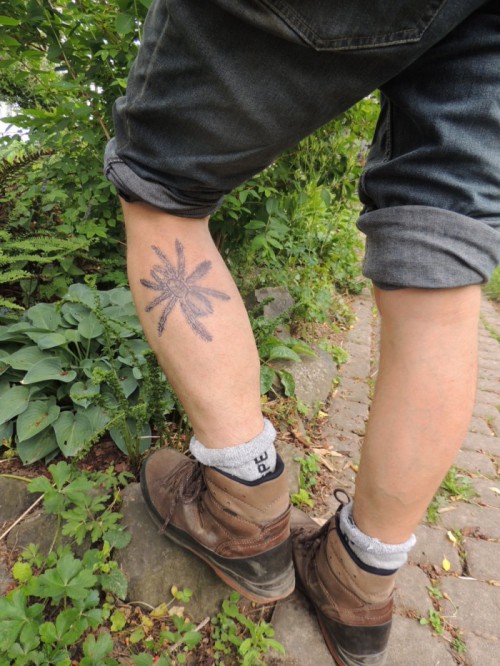
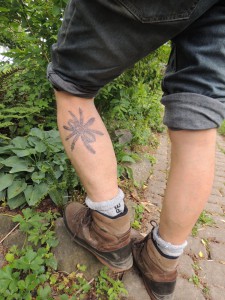
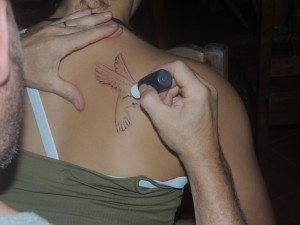
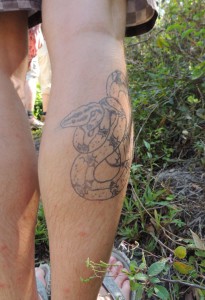
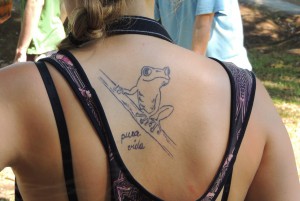
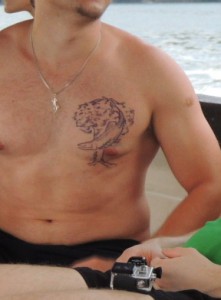



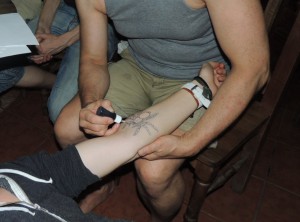
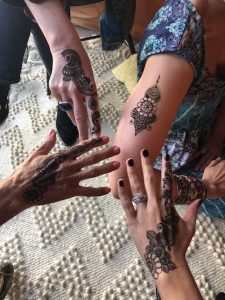

Comments
I loved this photo design.
great blog. Thanks sharing with us. Really valuable information.